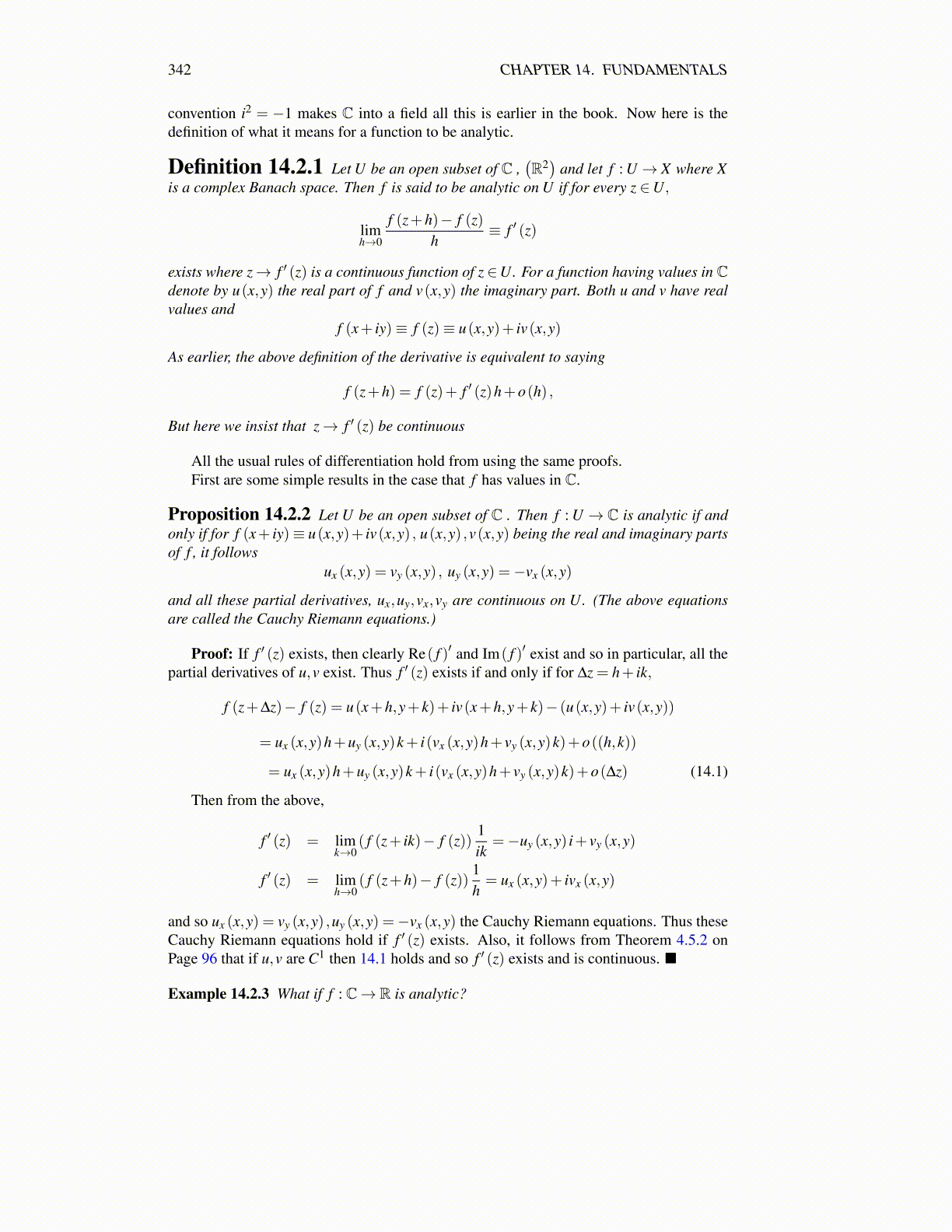
342 CHAPTER 14. FUNDAMENTALS
convention i2 = −1 makes C into a field all this is earlier in the book. Now here is thedefinition of what it means for a function to be analytic.
Definition 14.2.1 Let U be an open subset of C ,(R2)
and let f : U → X where Xis a complex Banach space. Then f is said to be analytic on U if for every z ∈U,
limh→0
f (z+h)− f (z)h
≡ f ′ (z)
exists where z→ f ′ (z) is a continuous function of z ∈U. For a function having values in Cdenote by u(x,y) the real part of f and v(x,y) the imaginary part. Both u and v have realvalues and
f (x+ iy)≡ f (z)≡ u(x,y)+ iv(x,y)
As earlier, the above definition of the derivative is equivalent to saying
f (z+h) = f (z)+ f ′ (z)h+o(h) ,
But here we insist that z→ f ′ (z) be continuous
All the usual rules of differentiation hold from using the same proofs.First are some simple results in the case that f has values in C.
Proposition 14.2.2 Let U be an open subset of C . Then f : U → C is analytic if andonly if for f (x+ iy)≡ u(x,y)+ iv(x,y) , u(x,y) ,v(x,y) being the real and imaginary partsof f , it follows
ux (x,y) = vy (x,y) , uy (x,y) =−vx (x,y)
and all these partial derivatives, ux,uy,vx,vy are continuous on U. (The above equationsare called the Cauchy Riemann equations.)
Proof: If f ′ (z) exists, then clearly Re( f )′ and Im( f )′ exist and so in particular, all thepartial derivatives of u,v exist. Thus f ′ (z) exists if and only if for ∆z = h+ ik,
f (z+∆z)− f (z) = u(x+h,y+ k)+ iv(x+h,y+ k)− (u(x,y)+ iv(x,y))
= ux (x,y)h+uy (x,y)k+ i(vx (x,y)h+ vy (x,y)k)+o((h,k))
= ux (x,y)h+uy (x,y)k+ i(vx (x,y)h+ vy (x,y)k)+o(∆z) (14.1)
Then from the above,
f ′ (z) = limk→0
( f (z+ ik)− f (z))1ik
=−uy (x,y) i+ vy (x,y)
f ′ (z) = limh→0
( f (z+h)− f (z))1h= ux (x,y)+ ivx (x,y)
and so ux (x,y) = vy (x,y) ,uy (x,y) =−vx (x,y) the Cauchy Riemann equations. Thus theseCauchy Riemann equations hold if f ′ (z) exists. Also, it follows from Theorem 4.5.2 onPage 96 that if u,v are C1 then 14.1 holds and so f ′ (z) exists and is continuous. ■
Example 14.2.3 What if f : C→ R is analytic?